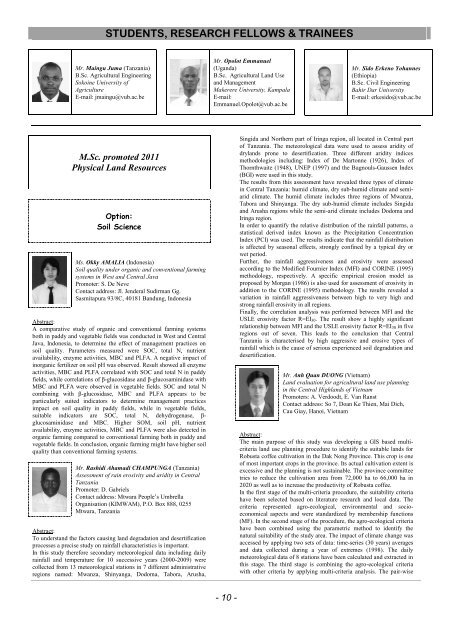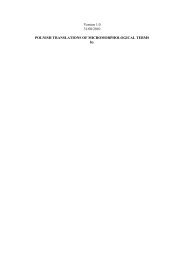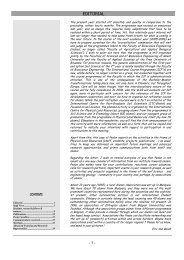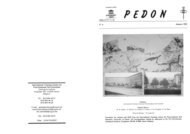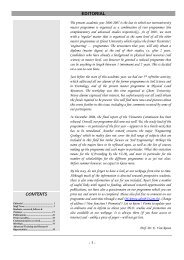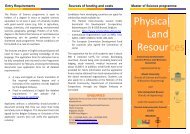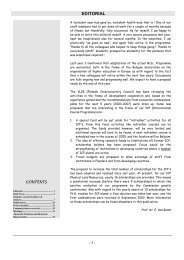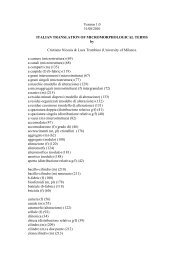Pedon 23 - Physical Land Resources - Universiteit Gent
Pedon 23 - Physical Land Resources - Universiteit Gent
Pedon 23 - Physical Land Resources - Universiteit Gent
Create successful ePaper yourself
Turn your PDF publications into a flip-book with our unique Google optimized e-Paper software.
STUDENTS, RESEARCH FELLOWS & TRAINEES<br />
Mr. Maingu Juma (Tanzania)<br />
B.Sc. Agricultural Engineering<br />
Sokoine University of<br />
Agriculture<br />
E-mail: jmaingu@vub.ac.be<br />
Mr. Opolot Emmanuel<br />
(Uganda)<br />
B.Sc. Agricultural <strong>Land</strong> Use<br />
and Management<br />
Makerere University, Kampala<br />
E-mail:<br />
Emmanuel.Opolot@vub.ac.be<br />
Mr. Sido Erkeno Yohannes<br />
(Ethiopia)<br />
B.Sc. Civil Engineering<br />
Bahir Dar University<br />
E-mail: erkesido@vub.ac.be<br />
M.Sc. promoted 2011<br />
<strong>Physical</strong> <strong>Land</strong> <strong>Resources</strong><br />
Option:<br />
Soil Science<br />
Ms. Okky AMALIA (Indonesia)<br />
Soil quality under organic and conventional farming<br />
systems in West and Central Java<br />
Promoter: S. De Neve<br />
Contact address: Jl. Jenderal Sudirman Gg.<br />
Sasmitapura 93/8C, 40181 Bandung, Indonesia<br />
Abstract:<br />
A comparative study of organic and conventional farming systems<br />
both in paddy and vegetable fields was conducted in West and Central<br />
Java, Indonesia, to determine the effect of management practices on<br />
soil quality. Parameters measured were SOC, total N, nutrient<br />
availability, enzyme activities, MBC and PLFA. A negative impact of<br />
inorganic fertilizer on soil pH was observed. Result showed all enzyme<br />
activities, MBC and PLFA correlated with SOC and total N in paddy<br />
fields, while correlations of β-glucosidase and β-glucosaminidase with<br />
MBC and PLFA were observed in vegetable fields. SOC and total N<br />
combining with β-glucosidase, MBC and PLFA appears to be<br />
particularly suited indicators to determine management practices<br />
impact on soil quality in paddy fields, while in vegetable fields,<br />
suitable indicators are SOC, total N, dehydrogenase, β-<br />
glucosaminidase and MBC. Higher SOM, soil pH, nutrient<br />
availability, enzyme activities, MBC and PLFA were also detected in<br />
organic farming compared to conventional farming both in paddy and<br />
vegetable fields. In conclusion, organic farming might have higher soil<br />
quality than conventional farming systems.<br />
Mr. Rashidi Ahamadi CHAMPUNGA (Tanzania)<br />
Assessment of rain erosivity and aridity in Central<br />
Tanzania<br />
Promoter: D. Gabriels<br />
Contact address: Mtwara People’s Umbrella<br />
Organisation (KIMWAM), P.O. Box 888, 0255<br />
Mtwara, Tanzania<br />
Abstract:<br />
To understand the factors causing land degradation and desertification<br />
processes a precise study on rainfall characteristics is important.<br />
In this study therefore secondary meteorological data including daily<br />
rainfall and temperature for 10 successive years (2000-2009) were<br />
collected from 13 meteorological stations in 7 different administrative<br />
regions named: Mwanza, Shinyanga, Dodoma, Tabora, Arusha,<br />
Singida and Northern part of Iringa region, all located in Central part<br />
of Tanzania. The meteorological data were used to assess aridity of<br />
drylands prone to desertification. Three different aridity indices<br />
methodologies including: Index of De Martonne (1926), Index of<br />
Thornthwaite (1948), UNEP (1997) and the Bagnouls-Gaussen Index<br />
(BGI) were used in this study.<br />
The results from this assessment have revealed three types of climate<br />
in Central Tanzania: humid climate, dry sub-humid climate and semiarid<br />
climate. The humid climate includes three regions of Mwanza,<br />
Tabora and Shinyanga. The dry sub-humid climate includes Singida<br />
and Arusha regions while the semi-arid climate includes Dodoma and<br />
Iringa region.<br />
In order to quantify the relative distribution of the rainfall patterns, a<br />
statistical derived index known as the Precipitation Concentration<br />
Index (PCI) was used. The results indicate that the rainfall distribution<br />
is affected by seasonal effects, strongly confined by a typical dry or<br />
wet period.<br />
Further, the rainfall aggressiveness and erosivity were assessed<br />
according to the Modified Fournier Index (MFI) and CORINE (1995)<br />
methodology, respectively. A specific empirical erosion model as<br />
proposed by Morgan (1986) is also used for assessment of erosivity in<br />
addition to the CORINE (1995) methodology. The results revealed a<br />
variation in rainfall aggressiveness between high to very high and<br />
strong rainfall erosivity in all regions.<br />
Finally, the correlation analysis was performed between MFI and the<br />
USLE erosivity factor R=EI 30. The result show a highly significant<br />
relationship between MFI and the USLE erosivity factor R=EI 30 in five<br />
regions out of seven. This leads to the conclusion that Central<br />
Tanzania is characterised by high aggressive and erosive types of<br />
rainfall which is the cause of serious experienced soil degradation and<br />
desertification.<br />
Mr. Anh Quan DUONG (Vietnam)<br />
<strong>Land</strong> evaluation for agricultural land use planning<br />
in the Central Highlands of Vietnam<br />
Promoters: A. Verdoodt, E. Van Ranst<br />
Contact address: So 7, Doan Ke Thien, Mai Dich,<br />
Cau Giay, Hanoi, Vietnam<br />
Abstract:<br />
The main purpose of this study was developing a GIS based multicriteria<br />
land use planning procedure to identify the suitable lands for<br />
Robusta coffee cultivation in the Dak Nong Province. This crop is one<br />
of most important crops in the province. Its actual cultivation extent is<br />
excessive and the planning is not sustainable. The province committee<br />
tries to reduce the cultivation area from 72,000 ha to 66,000 ha in<br />
2020 as well as to increase the productivity of Robusta coffee.<br />
In the first stage of the multi-criteria procedure, the suitability criteria<br />
have been selected based on literature research and local data. The<br />
criteria represented agro-ecological, environmental and socioeconomical<br />
aspects and were standardized by membership functions<br />
(MF). In the second stage of the procedure, the agro-ecological criteria<br />
have been combined using the parametric method to identify the<br />
natural suitability of the study area. The impact of climate change was<br />
accessed by applying two sets of data: time-series (30 years) averages<br />
and data collected during a year of extremes (1998). The daily<br />
meteorological data of 8 stations have been calculated and extracted in<br />
this stage. The third stage is combining the agro-ecological criteria<br />
with other criteria by applying multi-criteria analysis. The pair-wise<br />
- 10 -


